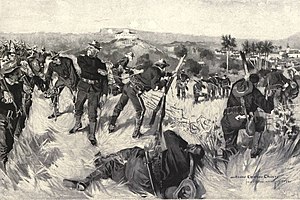Battle of El Caney
| Battle of El Caney | |||||||
|---|---|---|---|---|---|---|---|
| Part of the Spanish–American War | |||||||
 "The Capture of El Caney" by Howard Chandler Christy |
|||||||
|
|||||||
| Belligerents | |||||||
|
|
|
||||||
| Commanders and leaders | |||||||
|
|
|
||||||
| Strength | |||||||
| 6,653 Americans 3,000 Cubans |
520 regulars ≈100 irregulars |
||||||
| Casualties and losses | |||||||
| 600 killed 360 wounded |
38 killed, 138 wounded and 160 captured | ||||||
The Battle of El Caney was fought on 1 July 1898, during the Spanish–American War in southeastern Cuba. Lawton succeeded in capturing the town, fort and blockhouses and protected the right flank of the main American attack on the Heights of San Juan to the south.
At El Caney, Cuba, 514 Spanish regular soldiers, together with approximately 100 armed Spanish and Cubans loyal to Spain under the command of General Joaquín Vara del Rey y Rubio were instructed to hold the northwest flank of Santiago against the American 2nd Division, Fifth Army Corps commanded by Brigadier General Henry Ware Lawton.
Although the Spanish defenders had no machine guns, they were well equipped with modern smokeless powder rifles and a battery of two modern breech-loading 80mm mountain howitzers (Cañón de 8 cm Plasencia Modelo 1874, designed by Colonel Plasencia of the Spanish Army) that also utilized smokeless ammunition. The Spanish regular infantry was armed with fast-firing M1893 7mm Mauser rifles, while the loyalists were equipped with single-shot Remington Rolling Block rifles in .43 Spanish (also using smokeless powder). Denied promised reinforcements from Santiago, Vara de Rey and his forces held over 6,000 Americans from their position for nearly twelve hours before retreating, preventing General Lawton's men from reinforcing the U.S. assault on San Juan Hill.
Some of the American forces were hindered by their equipment; in the case of the 2nd Massachusetts, the men were equipped with antiquated black-powder single-shot .45-70 Springfield rifles. According to Frederick E. Pierce, a trooper of the 2nd Massachusetts, the Americans "received such a shower of bullets that it seemed at one time as if the company must be wiped out of existence." Because of this unequal contest, the 2nd Massachusetts was later taken out of the line and replaced with troops armed with more modern weapons.
The American forces also lacked effective support fire, as the single Gatling Gun Detachment had been sent to support the troops assaulting San Juan heights. General Lawton's artillery support consisted of a single battery of four 3.2-inch (81 mm) Model 1885 field guns—light breech-loading rifled cannon using black-powder ammunition. The relatively short range of the American gun battery—together with the signature cloud of black smoke generated with each volley—forced gun crews to endure a fusillade of Mauser rifle fire from the Spanish defenders. General Lawton's initial decision to continually shift the battery's fire to multiple targets resulted in minimal effect on the Spanish strongpoints. Continued assaults took a heavy toll of the attackers. During the fighting, General Vara del Rey was wounded in both legs and was captured by American troops. While being evacuated on a stretcher, Vara del Rey and his American escorts came under intense Spanish fire, killing the stretcher bearers and several American officers accompanying the group. A new set of stretcher bearers arrived, but a loyalist .43 Remington bullet then hit Vara del Rey in the head, killing him. With no one to evacuate, the stretcher bearers left the body on the field. His body was later found after the battle by a group of Spanish officers sent to locate him, and he was buried nearby. Despite Vara del Rey's death, Spanish resistance continued.
...
Wikipedia
